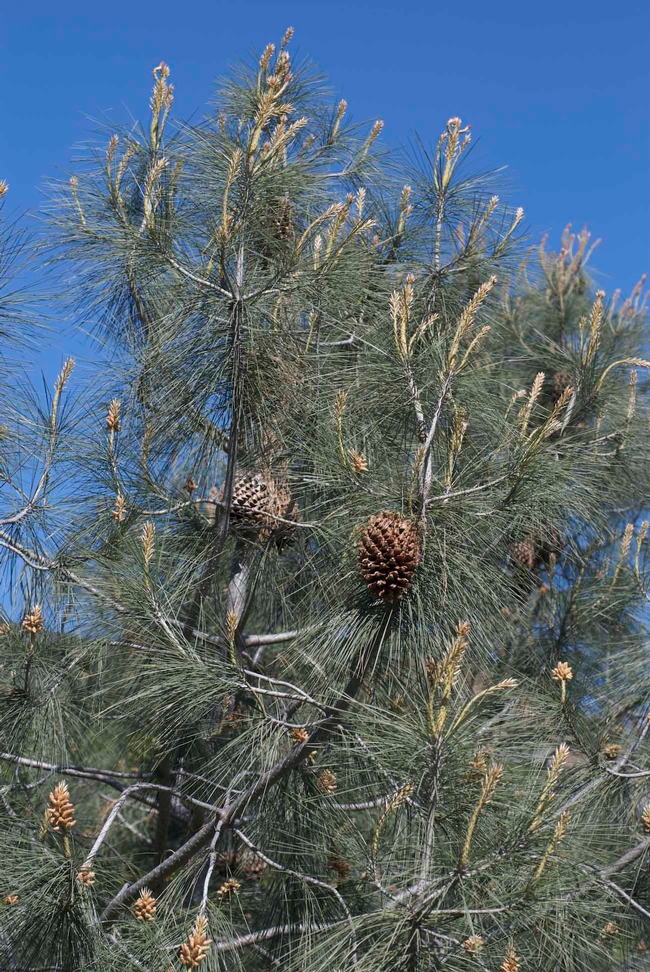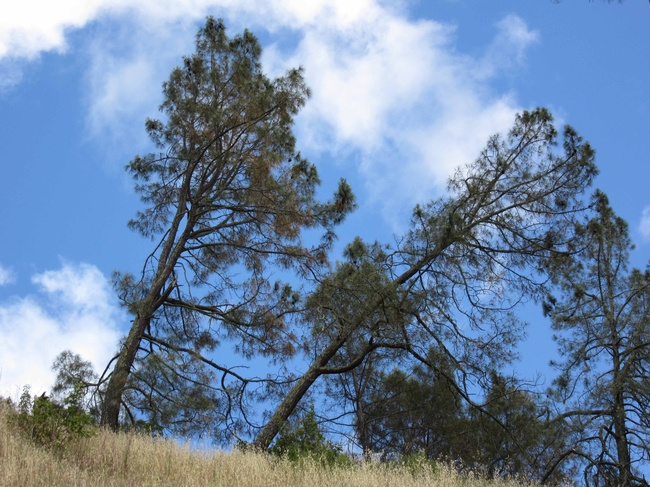Finding an Ecological Niche: A Three-Part Series on Selected Foothill Woodland and Chaparral Species, Part 2 of 3: The Gray Pine
By Laura Lukes, UC Master Gardener of Butte County, March 8, 2019
[Note: Gray pine (Pinus sabiniana), buckeye (Aesculus californica), and blue oak (Quercus douglasii) are tree species that thrive in rugged local foothill woodland and chaparral habitat. Last edition, we covered the blue oak, and today the gray pine is featured. The final installment will explore the buckeye. All three species rely on adaptive strategies evolved over time allowing them to thrive in their challenging environment.]

But underneath that homely exterior lies a true gem. This tree's many common names testify to its importance: gray pine, California foothill pine, foothill pine, nut pine, bull pine, and ghost pine. Its pejorative historic name, digger pine, is no longer in use. The Maidu named it “towáni” and the Yana called it “c'ala'I.” Its scientific name derives from the English lawyer, naturalist, and writer on horticulture Joseph Sabine (1770 to 1837). Sabine had a lifelong interest in natural history and was an original fellow of the Linnean Society. It was Sabine who was responsible for sending David Douglas on specimen collecting trips, specifically to supply plants to the Royal Horticultural Society Gardens.
We are not certain of the lifespan of the gray pine, because older specimens were cut down by early settlers, but it is believed that these trees can live for over 200 years. When mature, they average from 40 to 80 feet tall. About 15 to 25 feet off the ground, gray pines develop two or more twisted stems that can grow at irregular angles to one another, resulting in a crown that appears open and ragged. Gray pine is self-pruning, and the remaining lowest branches will end up high above the understory. Where soils allow, gray pines can develop a deep taproot, but in hardpan soils their roots are spreading and shallow, and the bark thickens as the tree ages.
The female cones are the largest and heaviest in the entire pine family. They could be mistaken for a football lying amongst shed needles, as they can be up to one foot long, and when dry are dull orange/brown. A green cone can weigh over two pounds. That, and their sharp spines, warn one to be alert while treading under this tree!
Like the blue oak, a common co-habitant, the gray pine is endemic to the California Sierra Nevada and Coast Range foothills. The two trees are so often found together that "oak/foothill pine vegetation" or "oak/gray pine vegetation" describes a type of habitat characteristic of the chaparral and woodlands ecoregion in California. Gray pines even surpass blue oaks in their ability to tolerate harsh conditions: they are found in the Transverse and Peninsular Ranges, and the Mojave Desert sky islands. They can handle from as little as 10 inches of rain per year to an annual 70 inches in parts of the Sierra Nevada. While these pines prefer rocky, well-drained soil, they will grow in notoriously poor serpentine soils and heavy, poorly drained clay soils. Their ability to withstand extreme soils comes from a special adaptive strategy: they are able to regulate uptake of soil nutrients as needed.
Surviving Drought and Fire
In an evolutionary adaptation to the dry hot summers of a Mediterranean climate, the gray pine has thin, gray needles up to 12 inches long that help it deflect heat and retain water. Surprisingly, this species is not fire resistant. On the contrary, it is highly flammable: its needles contain ether extracts; its wood, bark, cones, and needle sheaths all contain pitch; and its trunk often is coated with resin that has dripped from wounds. Its fire survival strategy lies in two specific adaptations. First, large trees will better survive moderate-severity fires because the thickened bark of mature trees and the self-pruned trunks with high branching limbs are best able to avoid fatal scorching. Second, seed regeneration is actually favored post-fire. As noted by the USDA, fire creates a receptive “bare mineral soil seedbed, and heat scarification of the woody seed coat increases germination rates.”

For California's native peoples, the gray pine was (and still is) a nutritional jackpot! Pine nuts are densely caloric, loaded with protein, easy to harvest, and store well for long periods. While many of California's pines provided food to native populations, the nuts of the gray pine were the most highly valued. They could be eaten raw, parched in baskets, and steamed in earth ovens. They were pounded into flour that was made into butter, soup, or bread; mixed with meal made from other dried seeds; and combined with dried salmon. In spring, green cones were roasted to yield a syrupy treat.
Every part of the pine tree had a use. Deadfall was used for firewood; needles served as tinder or were fashioned into torches and were also burned as a smudge for spider bites. Fresh, frangrant needles were spread on the floor of earth lodges. Supple branches were used as stirring sticks and to lift hot rocks from fires. Pine roots were used in basketry and the pine's abundant resin was used for medicinal purposes. Traditionally this species provided vital resources to native peoples. One can only imagine how horrifying it must have been for the tribes that relied so heavily on this tree, to see most of the old growth pines “harvested” during the Gold Rush era to fuel the engines at quartz mines.
Crooked, ragged, and awkward as the gray pine may appear, its ability to thrive under environmental hardship, and its value to native peoples' survival make it an ecological and cultural champion. After all, handsome is as handsome does.
For sources and further information, see the following:
M. Kat Anderson, Tending the Wild: Native American Knowledge and the Management of California's Natural Resources (University of California Press, 2005).
Laura Brodhead, “Native Plant Society: An appreciation of the gray pine,” Redding Record Searchlight, February 4, 2017:
Conifer Society: http://conifersociety.org/conifers/conifer/pinus/sabiniana/
USDA: https://www.fs.fed.us/database/feis/plants/tree/pinsab/all.html
Trees of Stanford: https://trees.stanford.edu/ENCYC/PINsab.htm
For more information on gardening in our area, visit the Butte County Master Gardener web page at: http://ucanr.edu/sites/bcmg/. If you have a gardening question or problem, call our Hotline at (530) 538-7201.
Photo credits:
Pine against the sky: http://www.treebuzz.com/forum/media/mature-digger-pine-trees-pinus-sabiniana.509/
Needles and cones: : https://commons.wikimedia.org/wiki/File:Pinus_sabiniana.jpg
Rising From the Ashes, March 8, 2019
The UC Master Gardeners of Butte County are taking note of vegetation re-emerging on property destroyed by the Camp Fire. Robert DiPietro reports that while the fire destroyed everything on his Lower Pentz Road property between Stearns and Country Club, he is now seeinggarlic, red onions, artichokes, day lilies, primrose, columbine, and bluebells appearing, along with all of the grasses and some succulents and cacti. Fay Crociani has a daffodil blooming on her Upper Paradise lot – its leaves and stem are shorter than usual, but the color is beautiful, and she says tulips and naked ladies (amaryllis belladonna) have also survived the fire, while stachys (7-up plant), ceanothus (mountain lilac), penstemon and aastache have put up identifiable shoots. She, too, says some of her succulents are showing signs of life. “Snooping around my neighborhood,” Fay reports, “I saw a badly damaged camellia blooming its heart out and a rhododendron with hundreds of new strong leaf buds. Mother Nature strong!!!”


